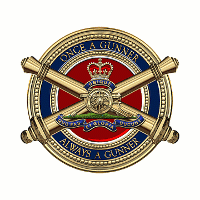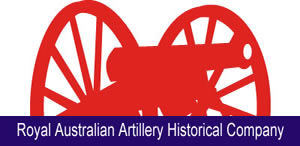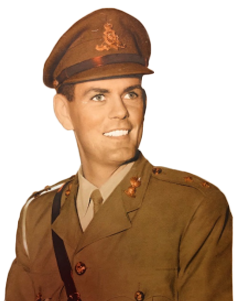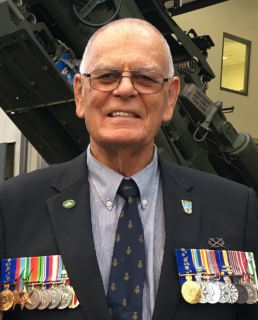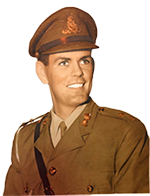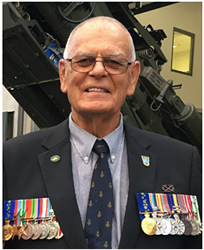| In 1968, Arthur, who was by then working in real estate and serving part-time as the Gun Position Officer (GPO) of 13th Field Battery, was offered a Short Service Commission in the Australian Regular Army to become the GPO of the 105th Field Battery for its forthcoming tour in South Vietnam. He accepted the challenge, beginning an association with the battery that would last a lifetime. As the principal technical officer at the gun line he was responsible for the proficiency of the instrument operators and signallers in the command post as well as the detachments on the gun line. He threw himself into the task with enthusiasm and dedication, insisting on a thorough knowledge of and compliance with authorised procedures. He set high standards and demanded them from himself and others.
The foundations he laid served the battery well throughout its operational tour. Arthur travelled to Vietnam with the advance party on 28 January 1969, and with scratch detachments fired the battery’s first mission on 4 February immediately before the main body arrived. He served as GPO for the next eight months, during which guns under his control deployed to sixteen different fire support bases for periods varying from a day to a month, and the battery fired in excess of 40,000 rounds. He proudly recalled later that he never made a mistake as Duty Officer. It was also in this period that he obtained a shipping container that he fitted out as the battery command post. Flown around by Chinook helicopter or transported on the back of a truck it greatly simplified the occupation of each new fire support base.
In September 1969 Arthur returned home on Rest and Recreation Leave to see Di and his new son, Sean. On return he became a Forward Observer with D Company, 5th Battalion, Royal Australian Regiment, before completing his tour of duty as the Regimental Intelligence Officer of the 1st Field Regiment and Duty Officer in the Artillery Tactical Headquarters of the 1st Australian Task Force
When 105th Battery returned to Australia on 4 February 1970, Arthur was granted a Permanent Commission and posted to 8th Medium Regiment at Holsworthy. Here he was promoted to Captain and became the Adjutant. While in this position he was selected to attend the Long Gunnery Staff Course (Field) at the Royal School of Artillery at Larkhill in the United Kingdom. He travelled overseas coincident with the birth of his second son, Justin, in August 1971, and returned in December 1972 after the birth of daughter, Lisa.
The Gunnery Staff Course prepared graduates to be an Instructor in Gunnery, and Arthur spent 1973 and 1974 in this role in Field Wing of the School of Artillery at Manly, before taking up a similar position on Headquarters 1st Division Artillery in Brisbane in 1975. Promoted to Major, he was selected for battery command, and to his delight posted to the 105th Field Battery, which was at Wacol as part of 1st Field Regiment. One of his subalterns recalls Arthur here perched on shooting stick, pipe in mouth, stopwatch in hand putting the command post through its paces.
On completion of his battery command, the Army selected Arthur for further overseas training, this time at the Royal Military College of Science at Shrivenham in the United Kingdom. On completion of this preparation for employment on the technical staff, he undertook general staff-officer training the Australian Army Staff College at Queenscliff, Victoria in 1979.
These qualifications behind him, Arthur was posted to Army Headquarters, firstly as a concepts officer in Logistics Branch, but then to a position in Materiel Branch admirably suited to his background: the construction and introduction into service of a new light 105mm gun. This was the ‘Hamel’ gun, named after the Australian battle in France in 1918. The choice of name, as well as Arthur’s insistence that the gun came with the Australian version of the traditional royal ciphers etched into the barrel, were early indicators of his passion for history and tradition. After five years and as the Lieutenant Colonel Defence Project Manager, he watched proudly as the first two guns rolled off the production line.
Arthur returned to Townsville in 1985 for what he considered the highlight of his career, command of the 4th Field Regiment. That he was chosen for this position having risen from the rank of Gunner was a testament to his ability. His Brigade Commander later commented that he relied heavily on Arthur’s wise advice and noted the ‘enthusiastic zeal’ with which Arthur commanded his unit.
After two successful years in command, Arthur was posted to the Operations Branch of 1st Division Headquarters in Brisbane. With children now in secondary school, he and Di faced the choice of continuing to move around or remaining in one location to provide stability in education. They put family first. Arthur moved to the 1st Army Reserve Training Group at Wacol where his approach and experience meant he was a valued mentor. He remained at the Training Group until reaching the statutory retiring age for Lieutenant Colonel in 1993.
His was a remarkable military career, influential in terms of his instructional and command positions, one of which he was justifiably proud. During his service he was awarded the Australian Active Service Medal with clasp ‘Vietnam’, the Vietnam Medal, the Defence Force Service Medal with first and second clasps, the National Medal, the Australian Defence Medal, the Republic of Vietnam Campaign Medal, and the Army Combat Badge. Arthur had been a great advocate for this badge, believing it inequitable that there should be a combat badge only for the infantry when soldiers from other arms and services had faced equal danger.
It was a source of considerable satisfaction to Arthur nine years after his retirement to be invited back into uniform as the Colonel Commandant (Honorary Colonel) of the Royal Australian Artillery for Queensland. He took up the position with typical gusto, visiting and mentoring all the artillery units in Queensland, serving with distinction for six years. The role also led to membership of the Royal Australian Artillery Historical Committee, where once again he freely gave of his time and knowledge to support the Regiment he so dearly loved.
It was a source of considerable satisfaction to Arthur nine years after his retirement to be invited back into uniform as the Colonel Commandant (Honorary Colonel) of the Royal Australian Artillery for Queensland. He took up the position with typical gusto, visiting and mentoring all the artillery units in Queensland, serving with distinction for six years. The role also led to membership of the Royal Australian Artillery Historical Committee, where once again he freely gave of his time and knowledge to support the Regiment he so dearly loved.
By this stage, Arthur was well into a remarkable second career of service to the community. Immediately upon leaving the Army he worked as an advocate with Legacy and joined the Corps of Commissionaires, but soon became deeply involved with the Anzac Day Commemoration Committee of Queensland, a Committee on which both he and Di would serve for more than two decades, Arthur finally as Honorary President, Di as the Merchandising Manager and Honorary Promotions and Education Officer. Together they helped transform the organization’s fund-raising and outreach. Arthur also became involved in the organization of Anzac Day in Brisbane, in particular the annual Anzac commemoration ceremony for students. For their contribution both were awarded the Centenary Medal and the Order of Australia Medal, recognition richly deserved.
Meanwhile, at the Welcome Home march for Vietnam Veterans in 1988, members of the 105th Battery from both its tours had resolved to form an association to foster comradeship. As a proud 105th Battery man, Arthur played an important role in the incorporating the association and its subsequent management. Realizing it would not thrive without communications, he took up the editorship of a bi-annual magazine ‘Tiger Rag’, which he raised to an incredibly high standard. Later he established a Battery Museum, a remarkable achievement that only a person of his drive and determination could have brought to fruition. It was through the Association that members got to know Arthur as a friend: generous, loyal, thoughtful, courteous and good fun. He was, as one member said, “instrumental in getting us all together and holding us together ever since”.
Arthur loved his golf, and both he and Di enjoyed their membership of the Wantima Country Club. In retirement he also indulged his passion for history, beginning a major work on the history of the 4th Field Regiment, and taking on numerous other projects. This in turn led to annual northern and southern progressions, in which he travelled the east coast researching and calling on old friends, always with flowers for the ladies, always with a bottle of Lagavulin to warm the cockles. Sadly, his work on 4th Field Regiment lies unfinished because, selflessly, he gave priority to works requested by others, and to demands on his time as a ‘tribal elder’ with a deep knowledge of artillery customs and traditions. In addition, for many years he provided a service to the wider artillery community by compiling the obituaries of Gunners humble and famous, who, to use his words, had gone to ‘the great gun park in the sky’.
Arthur was a great coordinator and connecter, good company, and a lover of social occasion. He and Di were generous hosts. At Shrivenham he was the convenor of the monthly diners’ club for non-British students. In Brisbane he fostered the Marine Corps lunch; coordinated the annual Gunner lunch for many years; was an active member of the Artillery Association and his RSL Sub-Branch; arranged lunches for veterans from the Gunner units that served in the 7th Division and their widows; and organized on 6 June each year a commemoration of the Battle of Binh Ba. He maintained a strong association with the 2/4th Field regiment Association. He kept in touch with his school friends. For many years he shared Saturday lunch and a wee dram with a widow he regarded as his second mother. Every day he raised the national flag at his house; each year he hosted Australia Day celebrations. He revelled in being a father and grandfather, and especially enjoyed those days when the grandchildren were entrusted to his care and he could take them on adventures.
With his passing the Gunners have lost a character. Arthur liked his style; the immaculate uniforms; the lace handkerchief, horse artillery trousers and spurs with his mess kit; the big cigar; the red wine; the single malt whisky. He was a man of passions as attested by his devotion to his family; his friends; the old Jaguar he never completely restored; his pipe, the cleaning of which involved a choreography as intricate as a Bolshoi ballet; his golf; history; and the Gunners. |
